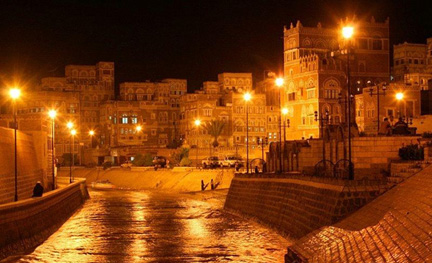

A friend sent these photographs of Sanaa, but I do not know the name of the photographer.


A friend sent these photographs of Sanaa, but I do not know the name of the photographer.
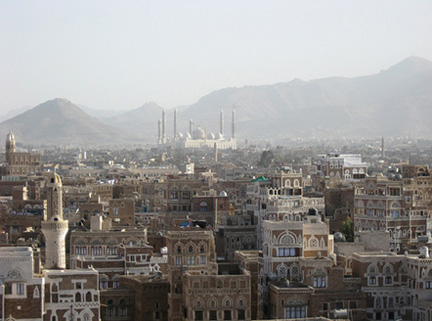

A friend sent these photographs of Sanaa, but I do not know the name of the photographer.

Bayt al-Hilali. Lighted middle floor was Wyatt’s home in Sanaa,Yemen (1970-72); Photo by Peggy Crawford (1988)
Is Yemen Really a Hotbed of Terrorism? “No,†says Author.
Arabian Nights and Daze Evokes a Friendlier Yemen than the Media Presents
Americans today have a negative image of Yemen and its people in the aftermath of media focus on radical Islam and terrorist activities in that country. Susan Clough Wyatt’s Arabian Nights and Daze: Living in Yemen with the Foreign Service provides timely insights into this vulnerable country, its history and culture, and the enormous challenges Yemen faces today. Arabian Nights and Daze has been selected as part of the Memoirs and Occasional Papers Series of the Association for Diplomatic Studies and Training (ADST) in Arlington, Virginia.
Journey back to 1970 when Wyatt and her Foreign Service officer husband reopened the U.S. diplomatic mission to the Yemen Arab Republic (YAR) after its closure at the time of the 1967 Arab-Israeli War. Arriving only eight years after progressive revolutionaries ousted a thousand-year-old dynasty of conservative Shiite Muslim imams, they found the mission in a shambles. Under the protection of the Italian embassy, they built it back in stages prior to full resumption of diplomatic relations with the YAR in 1972. Continue reading Arabian Nights and Daze
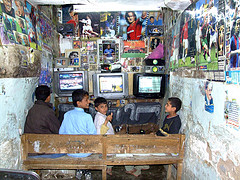
Internet cafes offer more to Yemen’s youth
by Teresa Gedi, Yemen Observer, April 3, 2010
Al-Mortazah internet cafe, located at the foot of the Friendship Bridge near Tahrir square, takes the meaning of internet café to another level. In addition to its 20 computer stations, it has a full service sheesha bar and cafe from which I enjoyed a glass of fresh mango juice courtesy of the soft-spoken poet and journalist Abdul Rahman Ghelan.
Mr. Ghelan, age 30, has frequented the café since his personal computer broke down some months ago. As the place is close to his home and affordable (1 riyal per minute), he takes his time exploring various literary and journalistic websites across the Arab world. Being a poet, Ghelan finds the web to be an effective means of spreading his work and developing it through feedback from the online literary community. Feeling I had stumbled on a budding international artist, I listened intently as he humbly explained his work which focuses largely on politics, women and children. “My poetry has benefited greatly from web exposure in both the Arab world and outside. Literary personalities in Europe for example have contacted me requesting to translate my work into other languages, specifically, French and Italian.†Ghelan is also currently working on a translation of a book into English entitled “Memoirs of the Victim,†the victim being women in Yemen. Another poem “hams al-abir†or “The Whisper of Perfume†has caused quite a stir in the online Arabic poetry community. “I am amazed by the support I receive online,†says Ghelan. “As long as you are appropriate and respectful, it feels like people are right next to you supporting you.†Continue reading Surfing in Sanaa

Women carry empty gas cylinders in Sana’a. The country is suffering from a gas shortage
Photograph: AFP/Getty Images
Several photographers have recently arrived in Yemen, given its newsworthiness. The Guardian has a gallery of 14 images. To see any earlier post on the photographs of Karim Ben Khelifa, click here.

The newly built presidential mosque, which cost an estimated $60 million; photography by Karim Ben Khelifa
Much of the reporting on recent events in Yemen is pathetic. A rare exception is the work of photojournalist Karim Ben Khelifa, who is currently on assignment in Yemen. Thus far he has posted two sets of photographs, one on the Wall Street Journal, and the other for the New York Times. Check out these websites for superb photographs, two of which I reprint here with the permission of the photographer.

Qât market in Sanaa, Yemen; photography by Karim Ben Khelifa
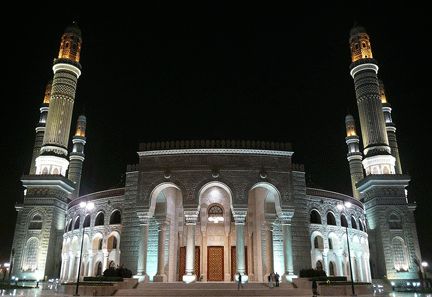
President’s new mosque in Sanaa, Yemen; photo by Arnaud Rat.
There is a short two-minute video taken recently by George Lewis in Sanaa, looking from the old city to the new mosque built by the president. To access this, click here.
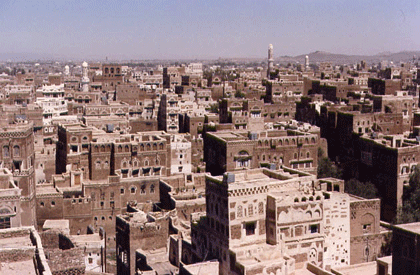
The Walled City of Sanaa
by Ronald Lewcock
[Note: This is an excerpt from Ronald Lewcock;s 1986 UNESCO book. The book is available online in its entirety in pdf format at http://www.worditude.com/ebooks/unescopdf/sana_eng.pdf.]
Viewing the old walled city of San‘a for the first time creates an unforgettable impression. And this vision of a childhood dream world of fantasy castles is not dispelled even on closer acquaintance. In the farmlands outside the city, on either side of the roads leading to it, buildings of all shapes – circular, rectangular, square – rise out of the flat highland plain to seemingly impossible heights constructed of apparently weak materials. Not merely does the stonework of the lower levels consist of rough rubble with loose mortar, but for most of their height the buildings are made of mud – layered mud, mud bricks of all sizes – and of mud-straw plaster, infinitely eroded by the monsoon rains until deep indentations mark the channels down which the autumnal torrents find their passage to the earth. Continue reading The Walled City of Sanaa